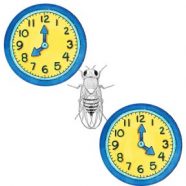Fruit fly brain has two clocks
Fruit flies have not one, but two built-in clocks to regulate daily activity.
By Emily Sohn
We are slaves to our clocks. They tell us when to get up in the morning, when to go to bed at night, and when to do everything in between—like eat and go to school.
Fruit flies are just as dependent on clocks as we are, with some important differences. Instead of having a timepiece with numbers on it, a fruit fly’s clock comes built into its body. And now, say two teams of scientists, each fly has not one, but two internal clocks.
 |
|
A fruit fly has two internal clocks instead of just one to tell it when to do what.
|
A number of creatures, including flies and mice, have two peaks of activity each day—one in the morning and one in the evening. In a lab, fruit flies will start buzzing around as the morning arrives, even if it’s still dark. In the evening, they get excited again right before the lights go out.
Scientists already knew that the insects have six clusters of cells in their brain that regulate the rhythm of their lives. Researchers have also identified genes that act in those clusters by telling the cells what to do. Flies that don’t have these clock genes don’t show daily rhythms in their activity.
To understand how the system works, a team of French researchers put one of those clock genes back into mutant flies that lacked a daily activity cycle. Results showed that when the gene was replaced in some clusters, it restored morning activity. When the clock gene was replaced in other clusters, it restored evening activity.
Destroying cell clusters in normal flies turned up a similar result. A group of scientists from Brandeis University in Waltham, Mass., found that knocking out clock-gene activity in some clusters made the flies less active in the morning. Knocking out others made the flies less active in the evening.
The findings of the two teams agreed on which are the morning-activity and evening-activity clusters.
This is the first time scientists have found specific cells for “morning-ness” and “evening-ness.” What’s next—a snooze gene?







